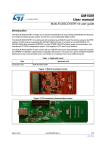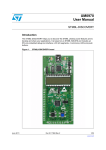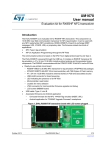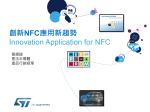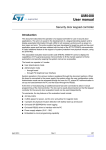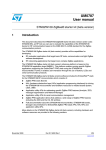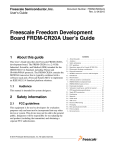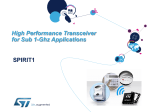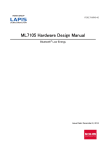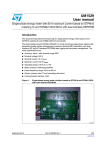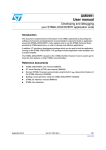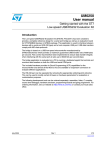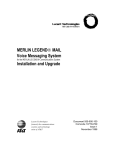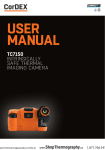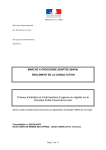Download User manual
Transcript
UM1589 User manual M24LR-Discovery kit user guide Introduction The M24LR-Discovery kit helps you evaluate the M24LRXX-E Dual Interface EEPROM that features an energy harvesting analog output, as well as a user-configurable digital output. The M24LR-Discovery kit is delivered with a battery-less M24LR board that can be powered by RFID readers or NFC phones supporting the ISO/IEC15693 protocol. It is based on an M24LR04E-R I²C ISO/IEC15693 Dual Interface EEPROM, an 8-bit STM8L152C6T6 ultralow power microcontroller, and includes an STTS751 temperature sensor, a 24-segment LCD, and 2 push buttons. The M24LR-Discovery kit also comes with an USB RF transceiver demonstration board that includes the CR95HF 13.56-MHz multi-protocol contactless transceiver. It is based on a 32-bit, STM32F103CBT6 performance line microcontroller and is connected to a computer host via its USB connector. Table 1. Applicable tools Type Evaluation tools Applicable tool M24LR-Discovery kit Figure 1. M24LR evaluation board Figure 2. RF transceiver demonstration board November 2012 Doc ID 023883 Rev 1 1/15 www.st.com Contents UM1589 Contents 1 Quick start . . . . . . . . . . . . . . . . . . . . . . . . . . . . . . . . . . . . . . . . . . . . . . . . . 3 1.1 Getting started with the M24LR04E Dual Interface EEPROM . . . . . . . . . . 3 1.2 Using the M24LR board with Android NFC phones . . . . . . . . . . . . . . . . . . 4 1.3 System requirements . . . . . . . . . . . . . . . . . . . . . . . . . . . . . . . . . . . . . . . . . 4 1.4 Development toolchain . . . . . . . . . . . . . . . . . . . . . . . . . . . . . . . . . . . . . . . . 4 2 Features . . . . . . . . . . . . . . . . . . . . . . . . . . . . . . . . . . . . . . . . . . . . . . . . . . . 5 3 Hardware and layout description . . . . . . . . . . . . . . . . . . . . . . . . . . . . . . . 6 3.1 M24LR board description . . . . . . . . . . . . . . . . . . . . . . . . . . . . . . . . . . . . . . 6 3.2 M24LR board power selection . . . . . . . . . . . . . . . . . . . . . . . . . . . . . . . . . . 7 3.3 RF transceiver board description . . . . . . . . . . . . . . . . . . . . . . . . . . . . . . . . 9 3.4 RF transceiver demonstration board powering and startup . . . . . . . . . . . . 9 3.5 Program/debug the M24LR board . . . . . . . . . . . . . . . . . . . . . . . . . . . . . . 10 3.6 Program/debug the RF transceiver demo board . . . . . . . . . . . . . . . . . . . 10 4 Electrical schematic diagrams . . . . . . . . . . . . . . . . . . . . . . . . . . . . . . . . 11 5 Revision history . . . . . . . . . . . . . . . . . . . . . . . . . . . . . . . . . . . . . . . . . . . 14 2/15 Doc ID 023883 Rev 1 UM1589 1 Quick start Quick start The M24LR-Discovery kit is a low-cost and ready-to-use development kit used to evaluate the functions and performance of the M24LR Dual Interface EEPROM family and its energy harvesting capability. For more information on the M24LR-Discovery kit and associated demonstration software, please visit www.st.com/m24lr04e-discovery. 1.1 Getting started with the M24LR04E Dual Interface EEPROM 1. On the M24LR board, ensure that a jumper is placed on connector JP1 in the RF power position (jumper on the right side as shown in Figure 4). 2. Download and install the M24LR/CR95HF demonstration software available at www.st.com/m24lr04e-discovery. 3. Connect the RF transceiver demo board to a PC with a USB cable. 4. Launch M24LRxx_Application_Software.exe, and select CR95HF Demo Kit. Then, open the Demo NDEF messages menu and select Show Demo NDEF & Energy Harvesting. 5. Place the M24LR board antenna close to the RF transceiver demo board antenna. 6. The M24LR board starts in Message Display mode (The “M24LR04E-DISCOVERY” message scrolls across the screen from right to left). You can read the current NDEF message stored in the M24LR04E-R by clicking the Read NDEF message button of the PC software. You can also write an new NDEF message: it will be automatically displayed on the M24LR board LCD screen after programming. 7. To change the user mode, press push button B2 (blue button on the left side of the board). Table 2 lists the user modes available. Table 2. Mode Available user modes Description 1 Displays the NDEF text message stored in the M24LR04E Dual Interface EEPROM. 2 Displays the voltage powering the M24LR board. 3 Displays the ambient temperature, measured using the temperature sensor. To study or modify the M24LR board application project related to this demo, please visit www.st.com/m24lr04e-discovery. Doc ID 023883 Rev 1 3/15 Quick start 1.2 UM1589 Using the M24LR board with Android NFC phones 1. Enable NFC communication on your phone (Settings >Wireless and Networks>NFC). 2. Download the NfcV-Reader Application from Google Play Store. 3. Launch the NfcV-Reader application. 4. Place the phone's NFC antenna close to the M24LR board antenna. The phone powers the M24LR board. The text message can be changed in the M24LR04E using the NFC phone (select NDEF function in the NfcV-Reader application and open the Write NDEF message menu). Please note that performance may vary depending on the NFC phone and its RF management system. 1.3 1.4 4/15 System requirements ● Windows® PC (XP or Vista) ● Two USB cables Development toolchain ● Cosmic CXSTM8 compiler ● STMicroelectronics ST Visual Develop (STVD) integrated development environment ● STMicroelectronics STLINK/V2 in-circuit debugger and programmer Doc ID 023883 Rev 1 UM1589 2 Features Features The M24LR-Discovery kit includes M24LR board and the RF transceiver board which offer the following features. M24LR board ● M24LR04E-R, a 4-Kbit EEPROM with an I²C-ISO/IEC 15693 dual interface and an energy harvesting analog output (Vout pin) and a user-configurable digital output (RF Write-in-progress or Busy pin) in an SO8N package ● 9-turn, 13.56-MHz etched antenna (20mm x 40mm) for RF powering and communication ● STM8L152C6T6, 8-bit ultralow power microcontroller with up to 32 Kbytes of Flash memory, 2 Kbytes of RAM, and 1 Kbyte of Data EEPROM in a 48-pin LQFP package ● STTS751 I²C low power temperature sensor ● 28-pin LCD on DIP24 socket (24 segments, 4 commons) ● Two push buttons (User and Reset) ● HC-49S-C20SSA, a 4-MHz crystal oscillator (not used in demonstration firmware) ● 4-pin connector (CN1) for STM8L programming and debug (SWIM) ● 2-pin connector (CN2) for external power supply source (3 to 6V) ● 5-pin connector (CN3) for M24LR04E-R and I²C bus probing ● 3-pin switch (JP1) to select M24LR board power source (M24LR04E Vout pin or external) RF transceiver board ● CR95HF, a 13.56-MHz multi-protocol contactless transceiver IC with SPI and UART serial access communication ● 2-turn, 13.56-MHz etched loop antenna (47mm x 34 mm) with associated tuning circuit and lowpass filter ● STM32F103CBT6, a 32-bit microcontroller with 128 Kbytes of Flash memory and USB interface in a 48-pin LQFP package ● KF33BDT, a 3.3V low dropout (LDO) voltage regulator ● USB connector ● NX2520SA, a 27.12-MHz EXS00A-CS01206 crystal oscillator for CR95HF transceiver ● HC-49XA-C20QQA-8.000MHz for STM32 ● 20-pin JTAG connector for STM32 programming and debugging ● 1 push button (Reset) Doc ID 023883 Rev 1 5/15 Hardware and layout description UM1589 3 Hardware and layout description 3.1 M24LR board description Figure 3. M24LR board layout 24-segment LCD (U3) Reset button (B1) User button (B2) M24LR board power selection connector (JP1) STM8L152C6T6 microcontroller (U1) SWIM connector (CN1) External power supply connector (CN2) M24LR04E-R and I²C connector (CN3) LDO voltage regulator for external power input (U5) 4-MHz crystal oscillator (X1) M24LR04E-R Dual interface EEPROM (U4) STTS751 I²C temperature sensor (U2) 9-turn, 13.56-MHz etched loop antenna 6/15 Doc ID 023883 Rev 1 UM1589 3.2 Hardware and layout description M24LR board power selection When jumper JP1 is set in the “RF power” position (Figure 4), the M24LR board is powered by the M24LR04E-R energy harvesting analog output (Vout pin). In this configuration, the M24LR board is powered by the magnetic field flowing into its 9-turn, etched loop antenna, delivered from a 13.56-MHz RF source, such as an RFID reader or an NFC phone. The DC voltage supply delivered by the M24LR04E-R Vout pin is filtered by an 10-nF capacitor (C19) and stored in the 150-µF capacitor (C22). The low dropout (LDO) voltage regulator (U5) is bypassed, so the M24LR04E-R voltage is filtered but not regulated. Figure 4. Jumper JP1 set in RF power position When jumperJP1 is set in the “REG 3.3" position (Figure 5), the M24LR board is powered by the external power supply connected on connector CN2. The voltage applied on the external power supply connector CN2 is regulated by the 3.3V voltage regulator (U5). The external power supply voltage can be from 3.3 to 6V. Using an external power supply is necessary when programming or debugging the STM8L MCU using the SWIM connector (CN1). Figure 5. Jumper JP1 in “REG_3V3” position and external power connection It is also possible to connect an external antenna demonstration board featuring the energy harvesting function (ANTX-M24LRXXE) to improve or simply evaluate the energy harvesting function using a different antenna. Doc ID 023883 Rev 1 7/15 Hardware and layout description UM1589 Figure 6 and Figure 7 illustrate the use of an external antenna using the ANT1-M24LR16E demonstration board. 8/15 ● Figure 6 shows a possible direct connection of the Vout voltage coming from the ANT1M24LR16E antenna demo board on jumper JP1 to bypass the voltage regulator (U5). ● Figure 7 shows the connection of the Vout voltage coming from the ANT1-M24LR16E antenna demo board on connector CN2 to use the voltage regulator (U5). Jumper JP1 must be set as shown in Figure 5. Figure 6. External antenna connection with voltage regulator bypass Figure 7. External antenna connection using M24LR board voltage regulator Doc ID 023883 Rev 1 UM1589 3.3 Hardware and layout description RF transceiver board description Figure 8. RF transceiver board layout (top and bottom) USB connector (J1) LDO regulator User LED 1 STM32F103CBT6 20-pin JTAG connector (J3) 27.12-MHz crystal oscillator CR95HF RF IC Reset button 2-turn,13.56-MHz loop antenna 3.4 RF transceiver demonstration board powering and startup The RF transceiver demonstration board is powered by the USB bus. When powered up, the CR95HF starts in an autonomous mode called “tag hunting”: the red LED 1 lights up every time a tag is recognized. During Tag Hunting mode, the RF transceiver demonstration board switches ON and OFF the magnetic field at each RF protocol change. A constant magnetic field is naturally more appropriate to evaluate and develop battery-less applications based on the Energy Harvesting capability of the M24LRXXE-R EEPROM Family. Tag Hunting mode persists until the M24LR/CR95HF demonstration software is launched and the CR95HF is initialized by the software. At this moment, both Tag Hunting mode and the RF field stop. To activate a constant magnetic field emission, it possible either to open the Demo NDEF messages menu and select Show Demo NDEF & Energy Harvesting or send a single ISO/IEC15693 RF command (Inventory, Read.). Doc ID 023883 Rev 1 9/15 Hardware and layout description 3.5 UM1589 Program/debug the M24LR board To program or debug an STM8L microcontroller application on the M24LR board, simply: 1. Set jumper JP1 in the “REG_3V3” position. 2. Connect an external power supply to the “3V3-6V” connector (CN2). 3. Connect the 4-pin SWIM connector of the STLINK/V2 in-circuit debugger and programmer to connector CN1 as described in Table 3. Table 3. 3.6 M24LR board programming and debug connector Pin CN2 Designation 1 Vcc VDD supply from M24LR board 2 PA0 SWIM data input/output 3 GND Ground supply 4 RESET SWIM reset Program/debug the RF transceiver demo board To program or debug an STM32 microcontroller application on the RF transceiver demonstration board, simply: 1. Connect the 20-pin JTAG/SWD flat ribbon of the STLINK/V2 in-circuit debugger and programmer to the RF transceiver demonstration board JTAG connector (J2). For more information, documentation about the STLINK/V2 in-circuit debugger and programmer, please visit www.st.com 10/15 Doc ID 023883 Rev 1 CN1 0 R3 C7 1uF[ceramic] VCC Not Fitted VCC 1 2 3 4 LCD_SEG23 LCD_SEG1 LCD_SEG2 LCD_SEG3 LCD_SEG4 LCD_SEG5 LCD_SEG6 LCD_SEG7 LCD_COM3 LCD_SEG8 LCD_SEG9 LCD_SEG10 VCC VCCA RESET# OSC_I N OSC_OUT LCD_COM0 LCD_COM1 LCD_COM2 LCD_SEG0 C1 1uF 1 2 3 4 5 6 7 8 9 10 11 12 13 14 15 16 17 18 19 20 21 22 23 24 STM8L 152C6T6 PA0 PA1 PA2 PA3 PA4 PA5 PA6 PA7 AVSS VDD VDDA VREF+ VL CD PE0 PE1 PE2 PE3 PE4 PE5 PD0 PD1 PD2 PD3 PB0 U1 C4 100nF VCC C3 100nF PE7 PE6 PC7 PC6 PC5 PC4 PC3 PC2 VSSI O VDDI O PC1 PC0 PD7 PD6 PD5 PD4 PF0 PB7 PB6 PB5 PB4 PB3 PB2 PB1 BEAD L1 48 47 46 45 44 43 42 41 40 39 38 37 36 35 34 33 32 31 30 29 28 27 26 25 C2 1uF U3 GH08172T RESET LED 5 4 3 2 1 2 1 3 2 660 R7 C8 100nF Vout BYPASS blue LD1 RESET# VCC B2 USER(Blue) C21 VCC [N/A] C22 C17 1uF[ceramic] C18 100nF C15 4.7uF 5 4 User 1 2 3 4 Antenna VCC C9 100nF R1 4K7 VCC TL NK157M006R2500(150uF) Z1 MMSZ 5227BT1(do not it)f LD3985M33R Vin INHI BI T GND U5 I2C connector I2C1_SCL I2C1_SDA RF_WI P/BUSY JP1 1 RF_POWER C16 1uF[ceramic] REG_3V3 Header 5 CN3 CN2 1 3 2 B1 RESET(Black ) External DC +3V3-6V I2C1_SCL I2C1_SDA LCD_SEG21 LCD_SEG20 LCD_SEG19 LCD_SEG18 RF_WI P/BUSY LCD_SEG17 LCD_SEG16 LCD_SEG15 LCD_SEG14 LCD_SEG13 LCD_SEG12 LCD_SEG11 VCC PE7 LED User_PB OSC32_OUT OSC32_ IN TemSensor_TNT LCD_SEG23 LCD_SEG22 TP1 VCCA C5 100nF 2 1 2 1 3 4 3 4 SWIM LCD_SEG22 28 28 27 1 1 2 LCD_SEG1 LCD_SEG0 2 27 LCD_SEG21 26 LCD_SEG20 25 25 3 26 4 LCD_SEG2 3 LCD_SEG18 LCD_SEG3 4 LCD_SEG19 24 5 LCD_SEG4 5 24 LCD_SEG17 23 6 LCD_SEG5 6 23 LCD_SEG16 22 7 LCD_SEG6 7 22 LCD_SEG15 21 8 LCD_SEG7 20 9 LCD_SEG8 9 21 LCD_SEG13 8 20 LCD_SEG14 19 19 10 LCD_SEG9 18 11 10 LCD_COM0 LCD_SEG10 11 18 LCD_SEG12 17 12 17 LCD_COM1 LCD_SEG11 12 16 COM0 COM3 15 COM1 COM2 14 13 Doc ID 023883 Rev 1 LCD_COM3 1 OSC32_ IN 0 R5 M24L R04E- RMN6T/2 8 7 6 5 VCC VCC I2C1_SDA TemSensor_TNT I2C1_SCL RF_WI P/BUSY I2C1_SCL I2C1_SDA R6 20K C14 10nFVCC R8 R9 R10 20K 15K 15K RF_POWER Vout VCC AC0 RF WI P/BUSY AC1 SCL VSS SDA 0 C13 STTS751-0WB3F 100nF C20 [N/A] 6 5 4 OSC32_OUT R4 33K U2 1 Addr/Therm SDA 2 GND EVENT 3 VDD SCL C19 10nF R11 U4 60 R2 X1 HC- 49S-C20SSA-4.000 OSC_I N OSC_OUT X2 MC306- G-06Q-32.768 (manufacturer JFVNY) 20pF C10 20pF C6 Not Fitted 6.8pF C11 6.8pF C12 VCC User_PB 2 3 Figure 9. 4 4 LCD_COM2 UM1589 Electrical schematic diagrams Electrical schematic diagrams M24LR board schematics 11/15 Electrical schematic diagrams UM1589 Figure 10. RF transceiver demonstration board schematics (STM32 connections) 12/15 Doc ID 023883 Rev 1 UM1589 Electrical schematic diagrams Figure 11. RF transceiver demonstration board schematics (CR95HF connections) Doc ID 023883 Rev 1 13/15 Revision history 5 UM1589 Revision history Table 4. 14/15 Document revision history Date Revision 06-Nov-2012 1 Changes Initial release. Doc ID 023883 Rev 1 UM1589 Please Read Carefully: Information in this document is provided solely in connection with ST products. STMicroelectronics NV and its subsidiaries (“ST”) reserve the right to make changes, corrections, modifications or improvements, to this document, and the products and services described herein at any time, without notice. All ST products are sold pursuant to ST’s terms and conditions of sale. Purchasers are solely responsible for the choice, selection and use of the ST products and services described herein, and ST assumes no liability whatsoever relating to the choice, selection or use of the ST products and services described herein. No license, express or implied, by estoppel or otherwise, to any intellectual property rights is granted under this document. If any part of this document refers to any third party products or services it shall not be deemed a license grant by ST for the use of such third party products or services, or any intellectual property contained therein or considered as a warranty covering the use in any manner whatsoever of such third party products or services or any intellectual property contained therein. UNLESS OTHERWISE SET FORTH IN ST’S TERMS AND CONDITIONS OF SALE ST DISCLAIMS ANY EXPRESS OR IMPLIED WARRANTY WITH RESPECT TO THE USE AND/OR SALE OF ST PRODUCTS INCLUDING WITHOUT LIMITATION IMPLIED WARRANTIES OF MERCHANTABILITY, FITNESS FOR A PARTICULAR PURPOSE (AND THEIR EQUIVALENTS UNDER THE LAWS OF ANY JURISDICTION), OR INFRINGEMENT OF ANY PATENT, COPYRIGHT OR OTHER INTELLECTUAL PROPERTY RIGHT. UNLESS EXPRESSLY APPROVED IN WRITING BY TWO AUTHORIZED ST REPRESENTATIVES, ST PRODUCTS ARE NOT RECOMMENDED, AUTHORIZED OR WARRANTED FOR USE IN MILITARY, AIR CRAFT, SPACE, LIFE SAVING, OR LIFE SUSTAINING APPLICATIONS, NOR IN PRODUCTS OR SYSTEMS WHERE FAILURE OR MALFUNCTION MAY RESULT IN PERSONAL INJURY, DEATH, OR SEVERE PROPERTY OR ENVIRONMENTAL DAMAGE. ST PRODUCTS WHICH ARE NOT SPECIFIED AS "AUTOMOTIVE GRADE" MAY ONLY BE USED IN AUTOMOTIVE APPLICATIONS AT USER’S OWN RISK. Resale of ST products with provisions different from the statements and/or technical features set forth in this document shall immediately void any warranty granted by ST for the ST product or service described herein and shall not create or extend in any manner whatsoever, any liability of ST. ST and the ST logo are trademarks or registered trademarks of ST in various countries. Information in this document supersedes and replaces all information previously supplied. The ST logo is a registered trademark of STMicroelectronics. All other names are the property of their respective owners. © 2012 STMicroelectronics - All rights reserved STMicroelectronics group of companies Australia - Belgium - Brazil - Canada - China - Czech Republic - Finland - France - Germany - Hong Kong - India - Israel - Italy - Japan Malaysia - Malta - Morocco - Philippines - Singapore - Spain - Sweden - Switzerland - United Kingdom - United States of America www.st.com Doc ID 023883 Rev 1 15/15















